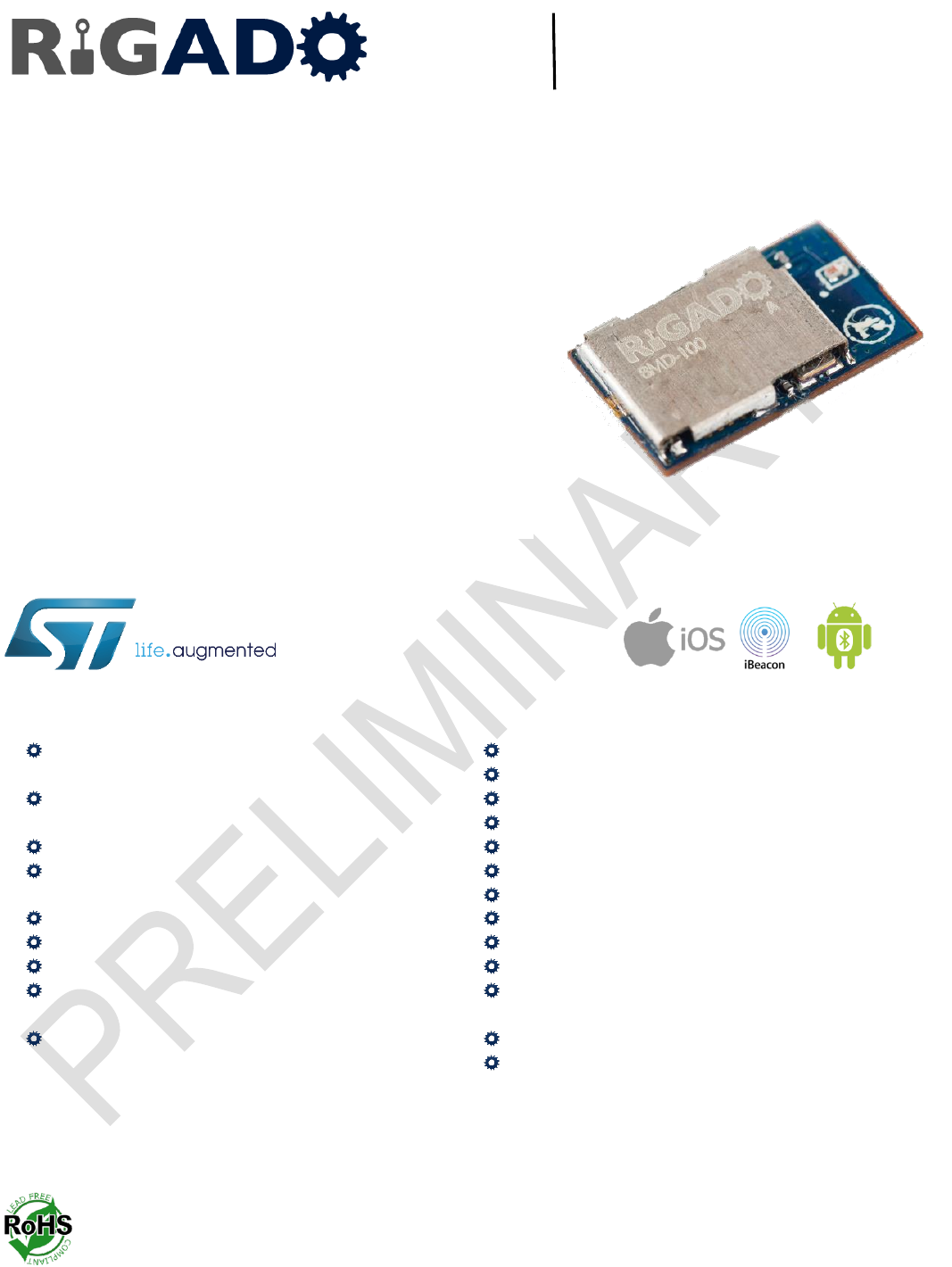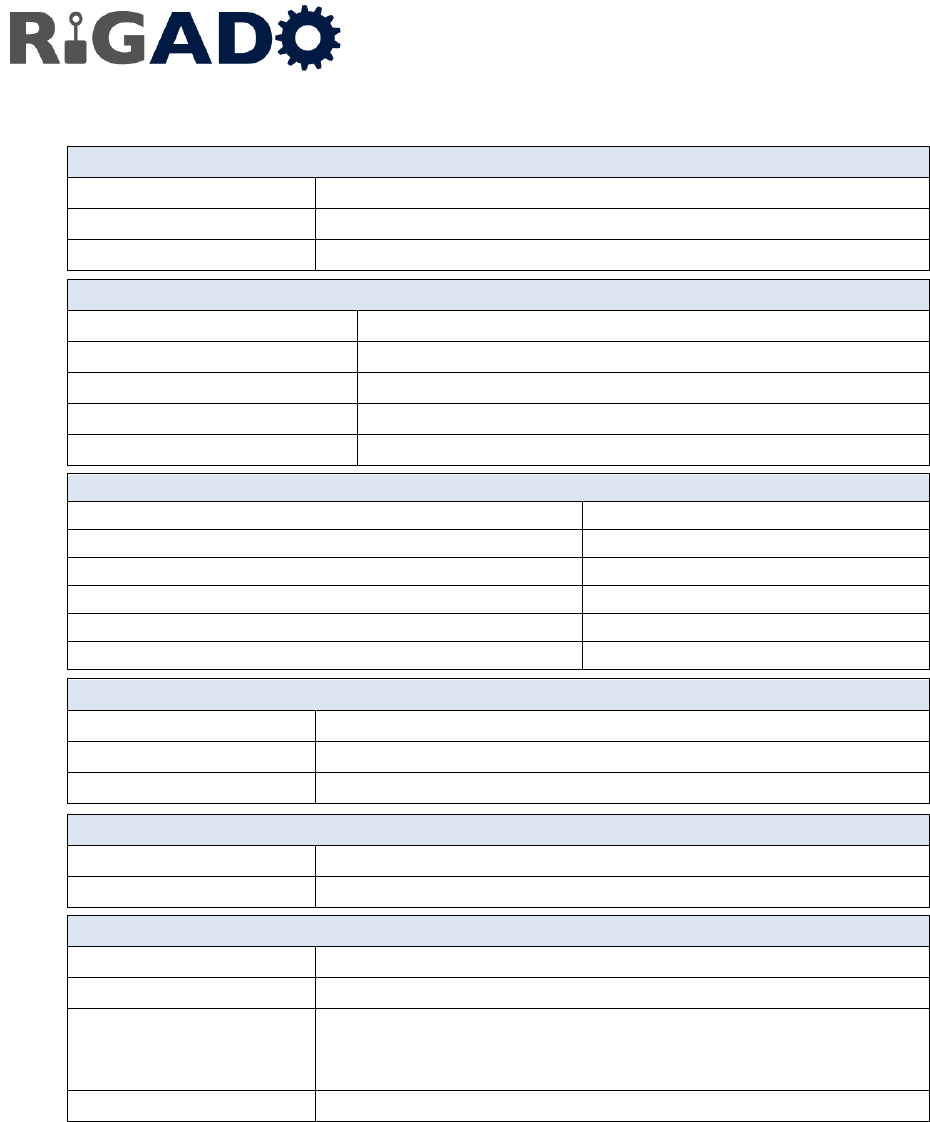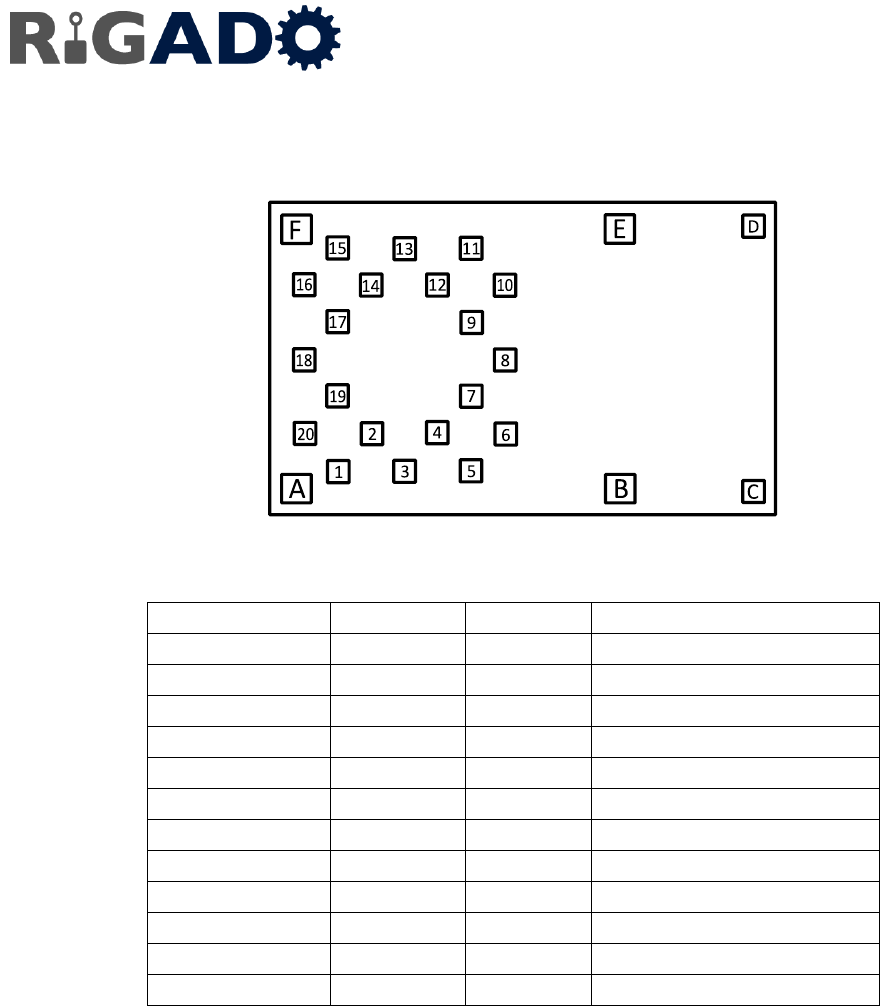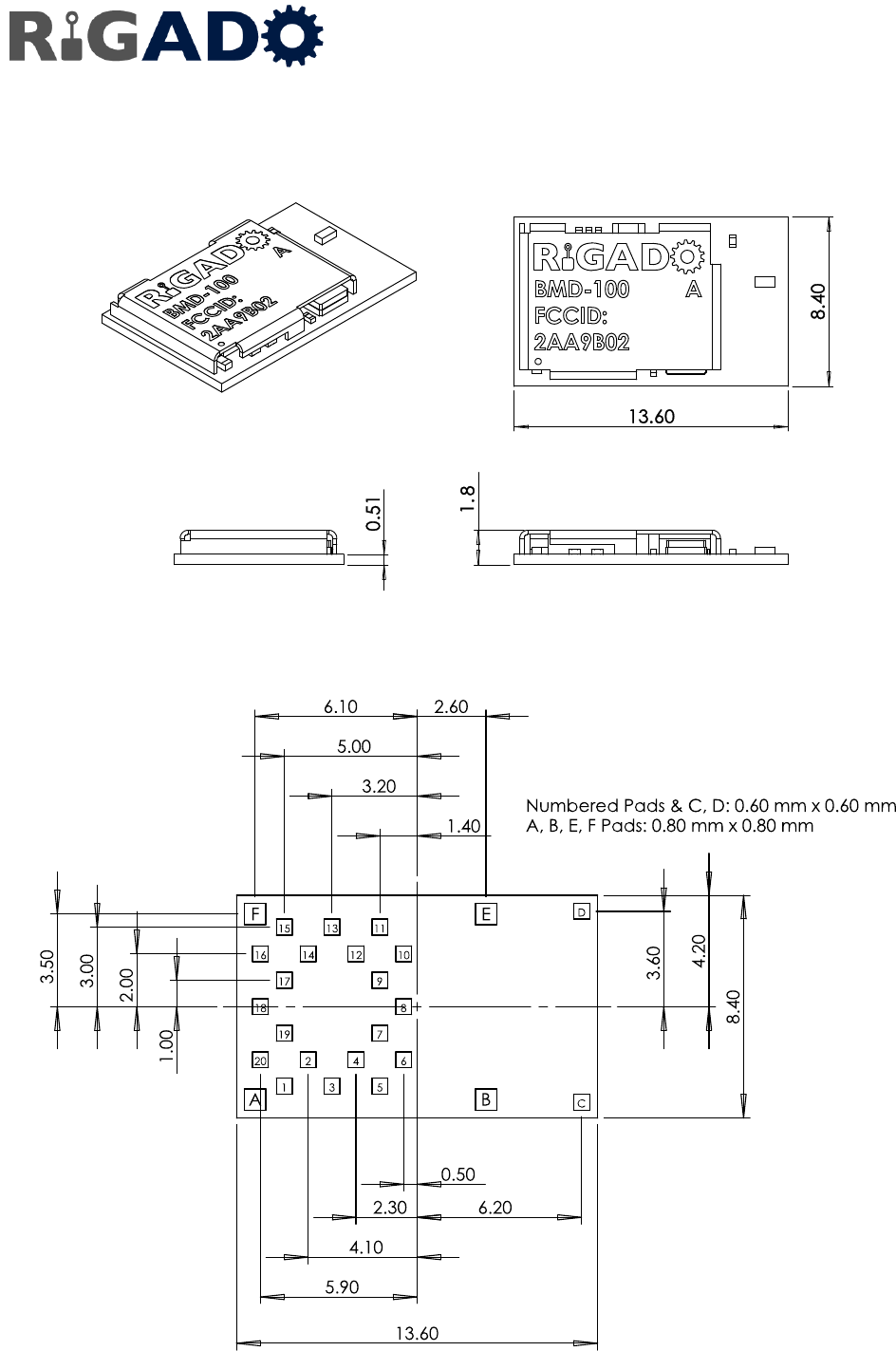User Manual

BMD-100-DS-V0.5 PRELIMINARY Page 1 of 17
Rigado LLC
2601 25
th
ST SE Suite 200
Salem, Oregon 97302
866-6-RIGADO modules@rigado.com
www.rigado.com/modules
BMD-100 Module for Bluetooth 4.1 LE
The BLUMOD BMD-100 is a Bluetooth Smart master/slave network
processor module targeted for low-power sensors and accessories
using the ultralow power STMicroelectronics BlueNRG-MS chipset.
It integrates features required for a Bluetooth Smart application,
including Bluetooth radio, software stack, and GATT/ATT-based
access. The external host application processor, where the
application resides, connects using SPI20. This allows the best
microcontroller for the application to be chosen and C based
Bluetooth Low Energy profiles are available for compiling into your
application.
The module can be powered directly from a standard 3V coin cell
battery or a pair of AAA batteries with a maximum input current of
only 15 mA at the highest output power. On-module flash memory
allows in the field Bluetooth low energy stack upgrades.
1. Features
Bluetooth v4.1 compliant master, slave and
multiple roles simultaneously
Embedded Bluetooth low energy protocol
stack: GAP, GATT, SM, L2CAP, LL, RF-PHY
C based Bluetooth low energy profiles
High performance, ultra-low power Cortex-M0
32-bit architecture core
SPI application controller interface (ACI)
Operating supply voltage: 1.7 to 3.6 V
8.2 mA maximum TX current (@0 dBm, 3.0 V)
Down to 1.7 μA current consumption with
active BLE stack
Integrated linear regulator and DC-DC step-
down converter
Up to +8 dBm available output power
Excellent RF link budget (up to 96 dB)
Accurate RSSI to allow power control
Full link controller and host security
On-chip non-volatile Flash memory
AES security co-processor
Low power modes
32 MHz crystal oscillator
32 kHz ring oscillator
Optional 32 kHz crystal oscillator
Battery voltage monitor and temperature
sensor
Operating temperature range: -40 °C to 85 °C
Bluetooth, FCC, IC, and CE certifications (Jan
2015)

BMD-100 Module Datasheet
Bluetooth 4.1 LE
1/5/2014
BMD-100-DS-V0.5 PRELIMINARY Page 2 of 17
2. Ordering Information
Email modules@rigado.com for quotes and ordering or visit www.rigado.com/bmd-100
Part Number
Description
BMD-100-A-R
BMD-100 module, Rev A, Tape & Reel
BMD-100-A-CT
BMD-100 module, Rev A, Cut Tape
BMD-100-NUCL
BMD-100 Nucleo Shield
BMD-100-EVAL
BMD-100 Evaluation Kit (Nucleo Shield + Nucleo Platform)
Table 1 - Ordering Part Numbers
3. Hardware Block Diagram
Figure 1 – Hardware Block Diagram
4. Software Block Diagram
Figure 2 – Software Block Diagram

BMD-100 Module Datasheet
Bluetooth 4.1 LE
1/5/2014
BMD-100-DS-V0.5 PRELIMINARY Page 3 of 17
Table of Contents
1. FEATURES .................................................................................................................................................................. 1
2. ORDERING INFORMATION ........................................................................................................................................ 2
3. HARDWARE BLOCK DIAGRAM ................................................................................................................................... 2
4. SOFTWARE BLOCK DIAGRAM .................................................................................................................................... 2
5. QUICK SPECIFICATIONS ............................................................................................................................................. 4
6. PIN DESCRIPTIONS .................................................................................................................................................... 5
7. ELECTRICAL SPECIFICATIONS ..................................................................................................................................... 6
7.1. ABSOLUTE MAXIMUM RATINGS ................................................................................................................................ 6
7.2. OPERATING CONDITIONS .......................................................................................................................................... 6
7.3. SPI INTERFACE ........................................................................................................................................................... 6
7.4. CLOCKS ....................................................................................................................................................................... 6
7.5. NOTE .......................................................................................................................................................................... 7
8. APPLICATION CONTROLLER INTERFACE ..................................................................................................................... 7
9. MECHANICAL DATA ................................................................................................................................................... 8
9.1. MODULE DIMENSIONS .............................................................................................................................................. 8
9.2. RECOMMENDED PCB LAND PAD ............................................................................................................................... 8
10. MODULE MARKING ................................................................................................................................................. 9
11. RF DESIGN NOTES.................................................................................................................................................... 9
11.1. RECOMMENDED RF LAYOUT & GROUND PLANE..................................................................................................... 9
11.2. MECHANICAL ENCLOSURE ..................................................................................................................................... 10
11.3. ANTENNA PATTERN ............................................................................................................................................... 10
11.3.1. S33 SMITH CHART ........................................................................................................................................... 10
11.3.2. 3D RADIATION PATTERN ................................................................................................................................. 10
11.3.3. XY-PLANE ......................................................................................................................................................... 10
11.3.4. XZ-PLANE ......................................................................................................................................................... 10
11.3.5. YZ-PLANE ......................................................................................................................................................... 10
12. EVALUATION BOARDS ........................................................................................................................................... 10
13. CUSTOM DEVELOPMENT ....................................................................................................................................... 11
14. BLUETOOTH CERTIFICATION .................................................................................................................................. 11
15. REGULATORY STATEMENTS .................................................................................................................................. 12
15.1. FCC STATEMENT: ................................................................................................................................................... 12
15.2. FCC IMPORTANT NOTES: ....................................................................................................................................... 12
15.3. IC STATEMENT: ...................................................................................................................................................... 13
15.4. IC IMPORTANT NOTES: .......................................................................................................................................... 13
15.5. CE REGULATORY: ................................................................................................................................................... 14
16. SOLDER REFLOW TEMPERATURE-TIME PROFILE .................................................................................................... 15
17. PACKAGING AND LABELING .................................................................................................................................. 15
17.1. CARRIER TAPE DIMENSIONS .................................................................................................................................. 15
17.2. REEL PACKAGING ................................................................................................................................................... 15
17.3. PACKAGING LABEL ................................................................................................................................................. 15
18. CAUTIONS ............................................................................................................................................................. 16
19. LIFE SUPPORT POLICY ............................................................................................................................................ 16
20. DOCUMENT HISTORY ............................................................................................................................................ 16
21. RELATED DOCUMENTS .......................................................................................................................................... 17

BMD-100 Module Datasheet
Bluetooth 4.1 LE
1/5/2014
BMD-100-DS-V0.5 PRELIMINARY Page 4 of 17
5. Quick Specifications
Bluetooth
Version
4.1 (Bluetooth Smart) Peripheral & Central
Security
AES-128
LE connections
up to 8
Radio
Frequency
2.402GHz to 2.480GHz
Modulation
GFSK at 1 Mbps
Transmit power
+8 dBm
Receiver sensitivity
-88 dBm (BLE mode)
Antenna
Integrated ceramic chip
Current Consumption
TX only @ +8 dBm, 4 dBm, 2 dBm
15.1 mA, 10.9 mA, 8.2 mA
RX only
7.7 mA
CPU, Flash and RAM on/off
3.3 mA, 2.0 mA
Sleep, 32kHz XO/RO
2.4 µA, 3.5 µA
Standby, (RAM2 Off)
1.3 µA
Reset
5 nA
Dimensions
Length
13.6 mm
Width
8.4 mm
Height
1.8 mm
Hardware
Interface
ACI over SPI with IRQ and Reset (8 MHz Max)
Power supply
1.7V to 3.6V
Planned Certifications (Jan 2015)
FCC
FCC part 15 modular qualification – FCC ID: 2AA9B03
IC
Industry Canada RSS-210 modular qualification – IC: 12208A-01
CE
EN 60950-1: 2011-01 3.1 (a) : Health and Safety of the User
EN 301 489-17 V2.2.1 3.1 (b) : Electromagnetic Compatibility
EN 300 328 V1.8.1 3.2 : Effective use of spectrum allocated
Bluetooth
Component (Tested) – DID: TBD
Table 2- Quick Specifications

BMD-100 Module Datasheet
Bluetooth 4.1 LE
1/5/2014
BMD-100-DS-V0.5 PRELIMINARY Page 5 of 17
6. Pin Descriptions
Figure 3- Pin out (Top View)
Pin description
Pin
Name
Direction
Description
14
SPI_CS
In
SPI slave select = SPI enable.
17
SPI_CLK
In
SPI clock (max 8 MHz).
16
SPI_MOSI
In
Master output, slave input.
15
SPI_MISO
Out
Master input, slave output.
18
SPI_IRQ
Out
Slave has data for master.
13
nRESET
In
Reset and deep sleep control
10
SXTAL0
In
32 kHz Crystal (optional)
12
SXTAL1
In
32 kHz Crystal (optional)
19
VCC
Pwr
+1.7 to +3.6VDC input 1
A,B,C,D,E,F,7,9,20
GND
Pwr
Electrical Ground
1,2,3,11
RESERVED
N/A
Connect to Ground
4,5,6,8
RESERVED
N/A
Leave Unconnected
Table 3 – Pin Descriptions
Note 1: An external capacitor for VCC is not strictly required, however a 1µF -
4.7µF ceramic capacitor is recommended.

BMD-100 Module Datasheet
Bluetooth 4.1 LE
1/5/2014
BMD-100-DS-V0.5 PRELIMINARY Page 6 of 17
7. Electrical Specifications
7.1. Absolute Maximum Ratings
Symbol
Parameter
Min.
Max.
Unit
VCC_MAX
Voltage on supply pin
-0.3
3.9
V
VIO_MAX
Voltage on SXTAL pins
-0.3
1.4
V
TS
Storage Temperature Range
-40
125
°C
VESD-HBM
Electrostatic discharge voltage
-2.0
2.0
kV
Table 4 – Absolute Maximum Ratings
7.2. Operating Conditions
Symbol
Parameter
Min.
Max.
Unit
VCC
Operating supply voltage
1.7
3.6
V
TA
Operating Ambient Temperature Range
-40
85
°C
Table 5 – Operating Conditions
7.3. SPI Interface
The application controller interface (ACI) uses a standard SPI slave interface as the transport
Layer on five physical wires:
2 control wires (clock and slave select)
2 data wires with serial shift-out (MOSI and MISO) in full duplex
1 wire to indicate data availability from the slave
All the SPI pins have an internal pull-down except for the SPI_CS that has a pull-up. All the SPI
pins, except the SPI_CS, are in high impedance state during the low-power states. The SPI_IRQ pin
requires an external pull-down resistor.
Symbol
Parameter
Min.
Typ.
Max.
Unit
FMAX
SPI Clock Max Frequency
8
MHz
TRISE
Rise Time
5
-
19
ns
TFALL
Fall Time
6
-
22
ns
VIH
Input High Voltage
0.65 x VCC
-
VCC
V
VIL
Input Low Voltage
VSS
-
0.35 x VCC
V
VOH
Output High Voltage (Vcc = 3.3V)
2.4
-
-
V
VOL
Output Low Voltage (Vcc = 3.3V)
-
-
0.4
V
RPU
Pull-up Resistance
11
13
16
kΩ
RPD
Pull-down Resistance
11
13
16
kΩ
Table 6 – SPI Interface
7.4. Clocks
The BMD-100 integrates two low-speed frequency oscillators (LSOSC) and two high-speed
(32 MHz) frequency oscillators (HSOSC).

BMD-100 Module Datasheet
Bluetooth 4.1 LE
1/5/2014
BMD-100-DS-V0.5 PRELIMINARY Page 7 of 17
The primary high frequency clock is a 32 MHz crystal oscillator. There is also a fast starting 12 MHz ring
oscillator that provides the clock while the crystal oscillator is starting up. Frequency tolerance of the high-
speed crystal is ±30 ppm.
The low frequency clock is used in Low Power mode and can be supplied either by a 32.7kHz oscillator that
uses an external crystal and guarantees up to ±50 ppm frequency tolerance, or by a ring oscillator with
maximum ±500 ppm frequency tolerance, which does not require any external components.
32.768 kHz Crystal Specification Requirements
Symbol
Parameter
Typ.
Max.
Unit
fnom
Crystal frequency
32.768
-
kHz
Ftol,BLE
Frequency tolerance
-
±50
ppm
PD
Load Capacitance
-
0.1
μW
Table 7 - 32.768 kHz Crystal
32.768 kHz Oscillator Comparison
Symbol
Parameter
Typ.
Max.
Unit
fnom
Crystal frequency
37.4
-
kHz
Ftol,BLE
Frequency tolerance
-
±500
ppm
Table 8 - 32.768 kHz Oscillator
7.5. Note
Additional electrical characteristics and current consumption data can be found on the BlueNRG-MS datasheet
provided by STMicroelectronics at www.st.com.
8. Application controller interface
The application controller interface is based on a standard SPI module with transfer rates up to 8
Mbits/s. The application controller Interface defines a software protocol providing functions to
access all the services offered by the layers of the embedded Bluetooth stack. The ACI
commands are described in the BlueNRG-MS ACI command interface document provided by
STMicroelectronics at www.st.com.

BMD-100 Module Datasheet
Bluetooth 4.1 LE
1/5/2014
BMD-100-DS-V0.5 PRELIMINARY Page 8 of 17
9. Mechanical Data
9.1. Module Dimensions
Figure 4- Module Dimensions
(All dimensions are in mm)
9.2. Recommended PCB Land Pad
Figure 5- Module Dimensions

BMD-100 Module Datasheet
Bluetooth 4.1 LE
1/5/2014
BMD-100-DS-V0.5 PRELIMINARY Page 9 of 17
(All dimensions are in mm)
10. Module Marking
Figure 6 – Module Marking – Rev A
11. RF Design Notes
11.1. Recommended RF Layout & Ground Plane
The integrated ceramic chip antenna requires a suitable ground plane to radiate effectively. Reducing the
ground plane from that shown in figure 7 will reduce the effective radiated power.
The BMD-100 module should be placed at the edge of the ground plane with the antenna side towards the
edge. Place a copper keep-out under the antenna (area shown in red). The area under the keep-out and
extending out from the edge of the ground plane should be kept clear of copper and other metal. The BMD-
100 uses a Johanson Technology 2450AT07A0100 chip antenna. Additional information on the antenna can be
acquired from www.johansontechnology.com.

BMD-100 Module Datasheet
Bluetooth 4.1 LE
1/5/2014
BMD-100-DS-V0.5 PRELIMINARY Page 10 of 17
Figure 7- Recommended RF Layout
11.2. Mechanical Enclosure
Care should be taken when designing and placing the module into an enclosure. Metal should be kept clear
from the antenna area, both above and below. Any metal around the module can negatively impact RF
performance.
The module is designed and tuned for the antenna and RF components to be in free air. Any potting, epoxy fill,
plastic overmolding, or conformal coating can negatively impact RF performance and must be evaluated by
the customer.
11.3. Antenna Pattern
TBD.
11.3.1. S33 Smith Chart
TBD.
11.3.2. 3D Radiation Pattern
TBD.
11.3.3. XY-plane
TBD.
11.3.4. XZ-plane
TBD.
11.3.5. YZ-plane
TBD.
12. Evaluation Boards
Rigado has developed a Nucleo-compatible shield for the BMD-100 that provides a complete development
solution for Bluetooth 4.1 LE.

BMD-100 Module Datasheet
Bluetooth 4.1 LE
1/5/2014
BMD-100-DS-V0.5 PRELIMINARY Page 11 of 17
13. Custom Development
Project specific firmware and hardware for the BMD-100 can be created or modified for customers. Custom
embedded development is available upon request. Please contact Rigado at info@rigado.com or 1-866-6-
RIGADO for custom engineering options and fees.
14. Bluetooth Certification
TBD.

BMD-100 Module Datasheet
Bluetooth 4.1 LE
1/5/2014
BMD-100-DS-V0.5 PRELIMINARY Page 12 of 17
15. Regulatory Statements
15.1. FCC Statement:
This device has been tested and found to comply with part 15 of the FCC rules. These limits are designed to
provide reasonable protection against harmful interference in a residential installation. This equipment
generates, uses and can radiate radio frequency energy and, if not installed and used in accordance with the
instructions, may cause harmful interference to radio communications. However, there is no guarantee that
interference will not occur in a particular installation. If this equipment does cause harmful interference to
radio or television reception, which can be determined by turning the equipment off and on, the user is
encouraged to try to correct the interference by one or more of the following measures:
Reorient or relocate the receiving antenna.
Increase the separation between the equipment and the receiver
Connect the equipment into an outlet on a circuit different from that to which the receiver is
connected.
Consult the dealer or an experienced radio/TV technician for help.
Operation is subjected to the following two conditions: (1) This device may no cause harmful interference, and
(2) this device must accept any interference received, including interference that may cause undesired
operation. Note: Modification to this product will void the user’s authority to operate this equipment.
Note: Modification to this product will void the users’ authority to operate this equipment.
15.2. FCC Important Notes:
(1) FCC Radiation Exposure Statement
This equipment complies with FCC RF radiation exposure limits set forth for an uncontrolled environment. This
transmitter must not be co-located or operating in conjunction with any other antenna or transmitter.
This equipment complies with Part 15 of the FCC Rules. Operation is subject the following two conditions:
(1) This device may not cause harmful interference, and
(2) This device must accept any interference received, including interference that may cause undesired
operation.
The devices must be installed and used in strict accordance with the manufacturer’s instructions as described
in the user documentation that comes with the product.
Caution!
The manufacturer is not responsible for any radio or TV interference caused by unauthorized modifications to
this equipment. Such modification could void the user authority to operate the equipment.
(2) Co-location Warning:
This device and its antenna(s) must not be co-located or operating in conjunction with any other antenna or
transmitter.
(3) OEM integration instructions:
This device is intended only for OEM integrators under the following conditions:
The transmitter module may not be co-located with any other transmit or antenna. The module shall be only
used with the integral antenna(s) that has been originally tested and certified with this module.

BMD-100 Module Datasheet
Bluetooth 4.1 LE
1/5/2014
BMD-100-DS-V0.5 PRELIMINARY Page 13 of 17
As long as the two (2) conditions above are met, further transmitter testing will not be required. However, the
OEM integrator is still responsible for testing their end-product for any additional compliance requirements
with this module installed (for example, digital device emission, PC peripheral requirements, etc.)
(4) OEM integration instructions:
In the event that these conditions cannot be met (for example certain laptop configuration or co-location with
another transmitter), then the FCC authorization for this module in combination with the host equipment is
no longer considered valid and the FCC ID of the module cannot be used on the final product. In these and
circumstance, the OEM integrator will be responsible for re-evaluating the end product (including the
transmitter) and obtaining a separate FCC authorization.
(5) End product labeling:
The final end product must be labeled in a visible area with the following: “Contains FCC ID: 2AA9B02”.
Any similar wording that expresses the same meaning may be used.
The FCC Statement below should also be included on the label. When not possible, the FCC Statement should
be included in the User Manual of the host device.
“This device complies with part 15 of the FCC rules.
Operation is subject to the following two conditions. (1) This device may not cause harmful
interference. (2) This device must accept any interference received, including interference that may
cause undesired operation. “
(6) Information that must be placed in the end user manual:
The OEM integrator has to be aware not to provide information to the end user regarding how to install or
remove this RF module in the user’s manual of the end product which integrates this module. The end user
manual shall include all required regulatory information/warning as show in this manual.
15.3. IC Statement:
This device complies with Industry Canada licence-exempt RSS standard(s). Operation is subject to the
following two conditions: (1) this device may not cause interference, and (2) this device must accept any
interference, including interference that may cause undesired operation of the device.
Le présent appareil est conforme aux CNR d'Industrie Canada applicables aux appareils radio exempts de
licence. L'exploitation est autorisée aux deux conditions suivantes : (1) l'appareil ne doit pas produire de
brouillage, et (2) l'utilisateur de l'appareil doit accepter tout brouillage radioélectrique subi, même si le
brouillage est susceptible d'en compromettre le fonctionnement.
RF exposure warning: The equipment complies with RF exposure limits set forth for an uncontrolled
environment. The antenna(s) used for this transmitter must not be co-located or operating in conjunction with
any other antenna or transmitter.
Avertissement d'exposition RF: L'équipement est conforme aux limites d'exposition aux RF établies pour un
incontrôlés environnement. L'antenne (s) utilisée pour ce transmetteur ne doit pas être co-localisés ou
onctionner en conjonction avec toute autre antenne ou transmetteur .
15.4. IC Important Notes:
1. The OEM integrator has to be aware not to provide information to the end user regarding how to install or
remove this RF module in the user manual of the end product.

BMD-100 Module Datasheet
Bluetooth 4.1 LE
1/5/2014
BMD-100-DS-V0.5 PRELIMINARY Page 14 of 17
The user manual provided by OEM integrators for end users must include the following information in a
prominent location.
2. To comply with IC RF exposure compliance requirements, the antenna used for this transmitter must not be
co‐located or operating in conjunction with any other antenna or transmitter, except in accordance with IC
multi‐transmitter product procedures.
3. The final system integrator must ensure there is no instruction provided in the user manual or customer
documentation indicating how to install or remove the transmitter module except such device has
implemented two‐ways authentication between module and the host system.
4. The host device shall be properly labeled to identify the module within the host device. The final end
product must be labeled in a visible area with the following: “Contains IC: 12208A-02”.
Any similar wording that expresses the same meaning may be used.
The IC Statement below should also be included on the label. When not possible, the IC Statement should be
included in the User Manual of the host device.
“This device complies with Industry Canada licence-exempt RSS standard(s). Operation is subject to
the following two conditions: (1) this device may not cause interference, and (2) this device must
accept any interference, including interference that may cause undesired operation of the device.
Le présent appareil est conforme aux CNR d'Industrie Canada applicables aux appareils radio exempts
de licence. L'exploitation est autorisée aux deux conditions suivantes : (1) l'appareil ne doit pas
produire de brouillage, et (2) l'utilisateur de l'appareil doit accepter tout brouillage radioélectrique
subi, même si le brouillage est susceptible d'en compromettre le onctionnement.”
15.5. CE Regulatory:
This device has been tested and has been found to be complaint against the following standards. OEM
integrators should consult with qualified test house to verify all regulatory requirements have been met for
their complete device.
From Directive 2006/95/EC:
EN 60950-1: 2006 + A11: 2009 + A1: 2010 + A12: 2011
From R&TTE Directive 1999/5/EC:
ETSI EN 300 440-1 V 1.6.1
ETSI EN 300 440-2 V 1.4.1
EN 62479:2010
From Directive 2004/108/EC:
ETSI EN 301 489-3 V1.6.1
ETSI EN 301 489-1 V1.9.2
Declarations of Conformity and supporting test reports are available upon request.

BMD-100 Module Datasheet
Bluetooth 4.1 LE
1/5/2014
BMD-100-DS-V0.5 PRELIMINARY Page 15 of 17
16. Solder Reflow Temperature-Time Profile
Figure 8 - Reflow Profile for Lead Free Solder
17. Packaging and Labeling
17.1. Carrier Tape Dimensions
TBD.
17.2. Reel Packaging
TBD.
17.3. Packaging Label
Figure 9 – Packaging Label

BMD-100 Module Datasheet
Bluetooth 4.1 LE
1/5/2014
BMD-100-DS-V0.5 PRELIMINARY Page 16 of 17
18. Cautions
1) The guidelines of this document should be followed in order to assure proper performance of the
module.
2) This product is for use in office, business, and residential applications, but not medical devices.
3) This module may short-circuit. If a short circuit can result in serious damage or injury then failsafe
precautions should be used. This could be accomplished by redundant systems and protection circuits.
4) Supply voltage to the module should not be higher than the specified inputs or reversed. Additionally
it should not contain noise, spikes, or AC ripple voltage.
5) Avoid use with other high frequency circuits.
6) Use methods to eliminate static electricity when working with the module as it can damage the
components.
7) Contact with wires, the enclosure, or any other objects should be avoided.
8) Refer to the recommended pattern when designing for this module.
9) If hand soldering is used, be sure to use the precautions outlined in this document.
10) This module should be kept away from heat, both during storage and after installation.
11) Do not drop or physically shock the module.
12) Do not damage the interface surfaces of the module.
13) The module should not be mechanically stressed at any time (storage, handling, installation).
14) Do not store or expose this module to:
Humid or salty air conditions
High concentrations of corrosive gasses.
Long durations of direct sunlight.
Temperatures lower than -40°C or higher than 125°C.
19. Life Support Policy
This product is not designed to be used in a life support device or system, or in applications where there is
potential for a failure or malfunction to, directly or indirectly, cause significant injury. By using this product in
an application that poses these risks, such as described above, the customer is agreeing to indemnify Rigado
for any damages that result.
20. Document History
Revision
Date
Changes / Notes
0.5
1/5/14
Initial Release - Preliminary

BMD-100 Module Datasheet
Bluetooth 4.1 LE
1/5/2014
BMD-100-DS-V0.5 PRELIMINARY Page 17 of 17
21. Related Documents
STMicroelectronics Documents:
DM00141263: BlueNRG-MS Datasheet